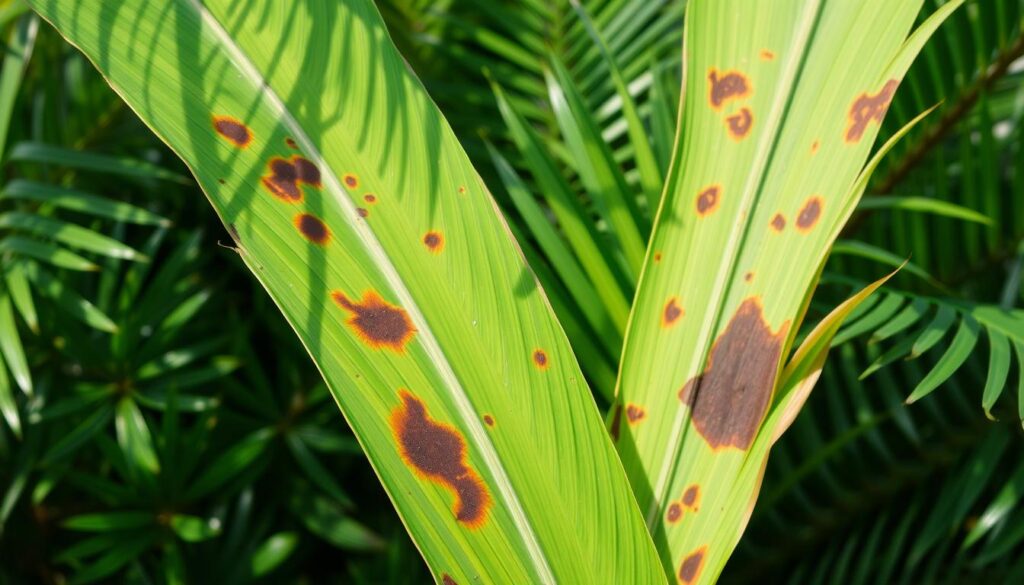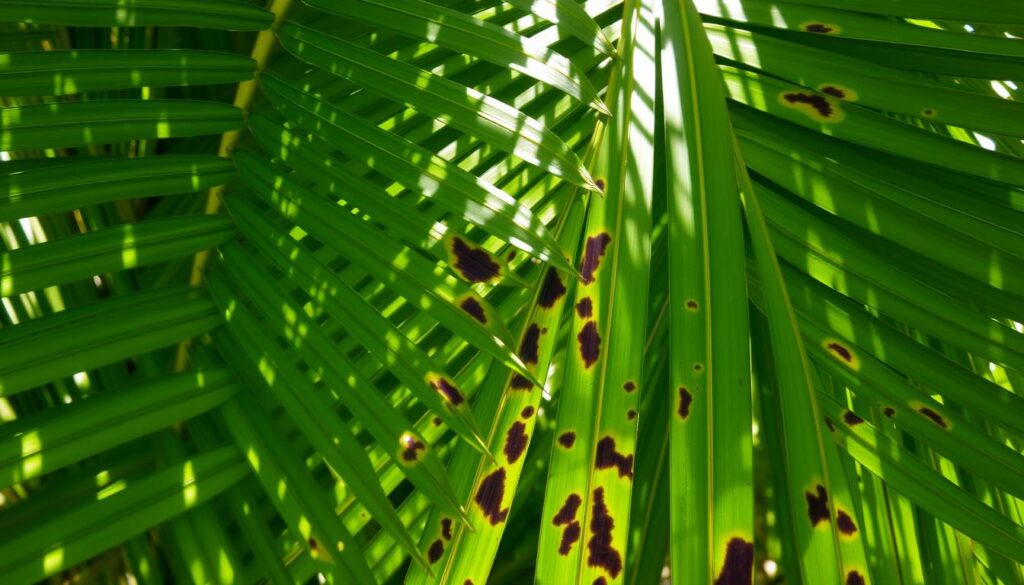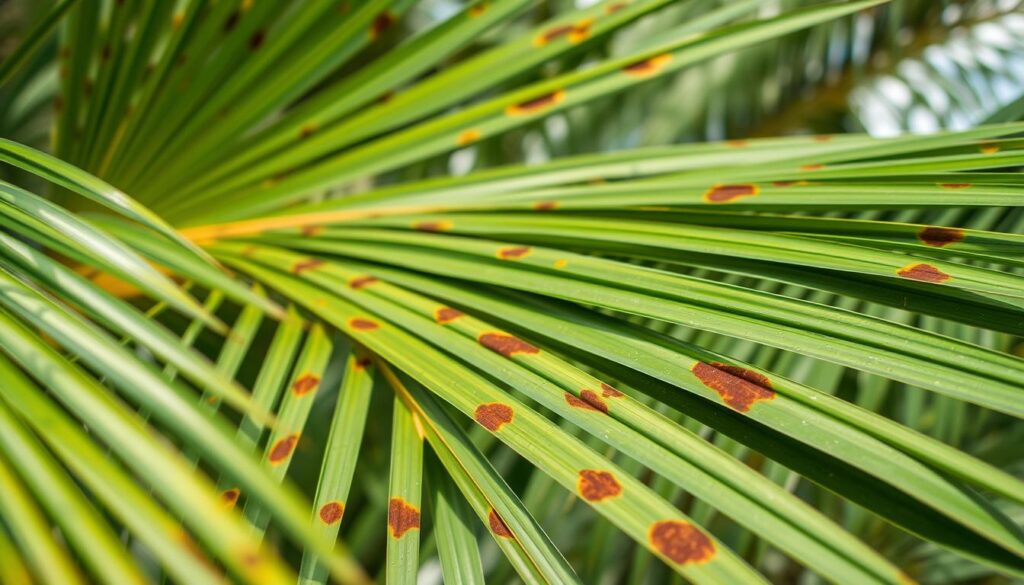Palm trees add beauty to any home landscape. But, brown spots under palm leaves can ruin their look. These spots can come from not enough nutrients, pests, or diseases. Knowing why they happen is key to making your palm tree healthy again.
A healthy palm tree is a joy to see, with its green leaves moving in the wind. But, brown spots on the leaves mean there’s a problem. These spots can be from too much or too little water, or not enough nutrients.
To fix brown spots, you need to find out why they’re there and fix it. This might mean changing how often you water, adding fertilizer, or trimming the tree. By caring for your palm tree well, you can stop brown spots and keep it looking great.
Table of Contents
Key Takeaways
- Brown spots on palm leaves can be caused by nutrient deficiencies, pests, and diseases.
- Overwatering and underwatering can lead to brown spots on palm tree leaves.
- Regular inspection and maintenance are key to stopping brown spots and keeping your palm tree healthy.
- Fertilization and pruning can help prevent brown spots and encourage healthy growth.
- Understanding the causes of brown spots is essential for fixing them and making your palm tree look good again.
- By using the right care, you can deal with brown spots on your palm tree and keep it strong.
- Keeping up with regular watering and fertilizing can stop brown spots and help your tree grow well.
Understanding Brown Spots on Palm Leaves
Palm trees have beautiful and strong leaves. But sometimes, these leaves can get brown spots. This can worry you. Brown spots might be due to not enough water, lacking nutrients, or diseases.
It’s key to know why these spots appear. This way, you can treat them right and stop more harm.
Some reasons for brown spots include nutrient deficiencies. This can be from not enough nitrogen, manganese, or magnesium. Pests and diseases can also cause black spots on palm leaves. To figure out the cause, check the tree’s water, food, and pest control.
At times, brown spots are just part of a leaf’s life. As leaves age, they might turn brown before new ones grow. But if many spots appear or leaves turn yellow or droopy, it’s a bigger problem.
| Cause | Symptoms | Treatment |
|---|---|---|
| Nutrient deficiency | Brown spots, yellowing leaves | Fertilize with balanced fertilizer |
| Pests | Black spots, sticky substance on leaves | Use insecticidal soap or neem oil |
| Diseases | Brown spots, black spots, leaf drop | Use fungicides, improve air circulation |
Knowing why brown spots happen and acting fast can help. This way, you can keep your palm tree healthy and strong.
Types of Palms Prone to Brown Spots
Palms can get spots on their leaves, which can look like circles or long shapes. These spots might be black or brown. They can be signs of disease. Some palms are more likely to get these spots than others.
Popular Palm Varieties with Issues
- Majesty Palm
- Areca Palm
These palms are more likely to get brown spots because they are sensitive. It’s important to check them often. This way, you can catch any problems early, like black spots on palm leaves.
Environmental Factors Influencing Palm Health
Things like temperature, humidity, and light can affect palm health. They can cause brown spots, including palm leaves black spots. Knowing this helps gardeners prevent spots and keep palms healthy.
Diagnosing Brown Spots on Your Palms
To find out why your palms have brown spots, you need to look closely at the leaves and tree. Seeing brown fronds on palm tree can tell you what’s wrong. It’s also key to check for pests or diseases, as they can harm your palm tree a lot.
A certified arborist can help figure out why your leaves are turning brown. They can also suggest the best ways to fix the problem. For example, palm tree care experts can find out why your majesty palm has brown spots on majesty palm.
Observing Leaf Patterns
When you look at the leaves, watch for signs of pests, diseases, or not enough nutrients. Some common problems that can make palms turn brown include:
- Pests, such as spider mites or scale insects
- Diseases, like leaf spot disease or root rot
- Nutrient deficiencies, like not enough potassium or manganese
Checking for Pests or Diseases
Make it a habit to check your palm tree for pests or diseases. Look for:
- Unusual growth patterns or color changes
- Pests, like spider mites or mealybugs
- Diseases, such as leaf spot or root rot
By following these steps, you can find out why your palms have brown spots. Then, you can take steps to make your palm tree healthy and look good again.
| Cause of Brown Spots | Symptoms | Treatment |
|---|---|---|
| Pests | Unusual growth patterns, discoloration | Insecticidal soap, neem oil |
| Diseases | Leaf spot, root rot | Fungicides, removal of infected leaves |
| Nutrient deficiencies | Yellowing or browning of leaves | Fertilization with potassium or manganese |
Preventive Measures for Healthy Palms
To keep your palms healthy, it’s important to give them the right care. This means knowing what they need to grow well and keeping up with regular maintenance. By doing these things, you can help your palms stay strong and vibrant.
Some key factors to consider include:
- Proper watering: Overwatering can lead to root rot, while underwatering can cause crispy, dry leaf edges.
- Fertilization: Applying balanced NPK fertilizers every 4-6 weeks during the growing season can help maintain palm health.
- Pruning: Regular pruning can help prevent the spread of disease and promote healthy growth.
Also, watching for pests and diseases is key to stopping brown spots on palm leaves. Regular checks can spot problems early. Quick action can stop big damage.

By taking these steps, you can keep your palms healthy. This reduces the chance of brown spots under palm leaves and on palm tree leaves.
| Preventive Measure | Benefits |
|---|---|
| Proper Watering | Prevents root rot and underwatering |
| Fertilization | Maintains palm health and promotes growth |
| Pruning | Prevents disease spread and promotes healthy growth |
Treatment Options for Brown Spots
Identifying the cause of brown spots on palm fronds is key to effective treatment. These spots can come from fungal infections, pests, or environmental stress. For example, black spots on palm tree leaves often mean a fungal infection. This can be treated with fungicides.
Natural remedies can also help. Adjusting how often you water and fertilize is important. Keeping humidity between 50-70% and ensuring good air flow can stop fungi. Regular inspections of leaves can catch problems early, allowing for quick action.
Chemical treatments, like fungicides, might be needed too. But use them carefully and as directed to protect your plant. Here are some common treatments:
- Applying a balanced, slow-release fertilizer every 6-8 weeks during the growing season
- Using insecticidal soap or horticultural oil to control pest infestations
- Pruning dead or damaged fronds to encourage new growth and improve overall plant appearance
Understanding the cause of brown spots and using the right treatment can help your palm fronds thrive. Always follow the right application rates and protect your plant.
Importance of Proper Watering
Watering palms right is key to keeping them healthy. Too much or too little water can cause brown spots on leaves. It’s important to water your palm when the soil starts to dry out.
Use a slow method to let water soak into the soil’s top 6 to 12 inches. Regular checks on palm leaves can spot early signs of trouble. Keeping the right water balance helps palms look their best.
Water palms every 1-2 weeks, adjusting as needed for your environment. This prevents both too much and too little water.
Signs of Overwatering vs. Underwatering
Too much water can turn leaves yellow and make roots mushy. Not enough water causes brown tips. Check soil moisture with your finger or a meter to avoid these problems.
A mix that drains well, like one with perlite and peat, stops water from pooling. This prevents root rot.
Best Practices for Palm Watering
- Water your palm before the soil becomes too dry
- Use a slow watering method to allow water to soak into the soil
- Assess soil moisture regularly to avoid overwatering and underwatering
- Use a well-draining potting mix to prevent water pooling
By following these tips, you can keep your palm fronds healthy and vibrant. This prevents brown spots and keeps your palm looking great.
The Role of Fertilizers in Plant Health
Fertilizers are key to keeping palm trees healthy. They help prevent brown spots on leaves and fronds. Palms need a mix of nutrients to grow well, and fertilizers provide these.
A good fertilizer for palms should have important micronutrients. These include magnesium, iron, and others. The NPK ratio for palms is 12-4-12, which helps with growth. But, using too much nitrogen can harm palms.
When using fertilizers, follow the guidelines to avoid harming your palms. Apply every 3 months to keep nutrients flowing. Make sure to cover the area around the palm’s roots.
To stop brown spots, keep your fertilizer use balanced. Check the soil’s pH too. By doing this, you can help your palms grow strong and avoid problems.
Sunlight and Its Impact on Brown Spots
Palms need bright, indirect light to grow well. Direct sunlight can cause black spots on palm tree leaves, harming the plant. It’s key to know how much light palms need to avoid palm leaves black spots.
Getting the right amount of sunlight is important. Some direct sunlight is good, but too much can cause brown spots. To keep leaves healthy, place palms near east- or west-facing windows. This way, they get indirect sunlight, preventing black spots on palm tree leaves.

For more tips on caring for your palms, check out housegardenia.com/style/. Learn about the right lighting and other care tips. Adjusting sunlight and providing the best conditions can prevent palm leaves black spots. This keeps your palms healthy and vibrant.
Identifying Pests That Cause Damage
Palm trees can face many pests, leading to brown spots and fronds. Pests like the Palm Leaf Skeletonizer, Red Date Scale, and Rugose Spiraling Whitefly are common culprits. These pests can seriously harm palms, causing brown spots and fronds.
The Food and Agriculture Organization notes that pests like the red palm weevil are very damaging. They can turn leaves yellow or brown. The red palm weevil is a major threat to palms worldwide, and can kill many trees.
Some common pests affecting palms include:
- Palm Leaf Skeletonizer
- Red Date Scale
- Rugose Spiraling Whitefly
- Red Palm Mite
- Palmetto Weevil
These pests have unique features. For example, the Palm Leaf Skeletonizer’s caterpillar stage is very damaging. The Red Date Scale is known for its white cottony wax.
To treat pests, it’s key to identify them and use the right methods. Systemic insecticides can fight red palm weevil, but they must be used early. Spotting symptoms like tunnels or frass in the palm’s center is important for early detection.
| Pest | Characteristics | Damage |
|---|---|---|
| Palm Leaf Skeletonizer | Caterpillar stage is most damaging | Brown spots on leaves |
| Red Date Scale | White cottony wax | Disrupts plant metabolic functions |
| Rugose Spiraling Whitefly | Large size, prefers coconut palms | Causes yellowing or browning of leaves |
The Significance of Humidity Levels
Palm trees love humid environments, best between 40-60% relative humidity. Brown spots on leaves can show if humidity is off. Keeping humidity right is key for palm health and avoiding brown spots.
Ideal Humidity for Palm Growth
Different palms like different humidities. For instance, Emerald Palms do best with 50-70% humidity. Too little humidity can cause leaves to wilt or turn brown. Too much can lead to fungal diseases.
Tips for Maintaining Humidity
To keep humidity right, try these tips:
- Use a humidifier to boost humidity around the palm
- Group plants to create a humid microclimate
- Avoid too much water to prevent root rot and improve water and nutrient uptake

By keeping humidity in check and following these tips, gardeners can stop brown spots. This helps palms grow well and lowers disease risk.
When to Consult a Professional
Proper care and maintenance can help prevent and treat brown spots on palm leaves. But, sometimes you need a professional’s help. If your efforts don’t work, or the problem gets worse, it’s time to call an arborist or plant specialist.
Signs You Need Expert Help
Severe or widespread brown spots that don’t get better are a sign you need help. Also, sudden changes in your palm’s health or appearance are red flags. Discoloration, stunted growth, and pest or disease signs are clear warnings.
How to Choose a Plant Specialist
Look for an International Society of Arboriculture (ISA) Certified Arborist in your area. They know how to diagnose and treat your palm’s problems. Also, ask for recommendations from other gardeners, nurseries, or online plant communities.
With a plant expert’s help, you can understand your palm’s needs better. They can create a plan to make your palm healthy again. Don’t be afraid to ask for professional help when DIY doesn’t work. It’s an investment for your palm’s long-term health.
Frequently Asked Questions
How to treat brown spots on palm plant leaves?
Brown spots on palm leaves can come from too much water, not enough water, pests, or fungal infections. To fix it:
Check watering habits – Let the soil dry slightly between waterings. Too much water leads to root rot.
Improve airflow – Stagnant air encourages fungal growth. Place the plant where it gets good air circulation.
Trim affected leaves – Cut off brown or yellowing leaves to stop the spread.
Use a fungicide – If it’s a fungal issue, apply a copper-based fungicide.
How do you treat brown leaf spot disease?
Brown leaf spot is often caused by fungus or bacteria. Here’s what to do:
Remove affected leaves – Prune the damaged parts to stop the spread.
Keep leaves dry – Avoid watering from above; wet leaves make the problem worse.
Apply a fungicide – Neem oil or copper fungicide can help.
Improve soil drainage – Waterlogged soil weakens the plant, making it easier for disease to take hold.
How to treat a palm tree with brown leaves?
If a palm’s leaves are turning brown, it might be due to improper watering, pests, or a nutrient deficiency. Try this:
Adjust watering – Water deeply but less often. If the soil feels soggy, cut back.
Check for pests – Spider mites and scale insects can damage leaves. Treat with insecticidal soap if needed.
Feed the plant – Palms need magnesium and potassium. Use a balanced fertilizer with these nutrients.
Remove damaged leaves – Trimming dead leaves keeps the plant healthy.
What is the brown spot under my leaf?
Brown spots underneath leaves could be caused by fungus, pests, or mineral deficiencies. Check for:
Fungal infections – If the spots spread or look fuzzy, it’s likely a fungus. Use a fungicide.
Pest damage – Tiny brown bumps or sticky residue might mean scale insects or mites. Use neem oil.
Nutrient issues – If the plant isn’t getting enough magnesium or calcium, it can develop brown spots. A fertilizer with micronutrients can help.
Can plants recover from brown spots?
Yes, but it depends on the cause. If you catch the issue early and fix the underlying problem (watering, pests, or nutrients), new leaves will grow healthy. However, damaged leaves won’t turn green again—it’s best to trim them.
What does an overwatered palm look like?
An overwatered palm may show these signs:
Yellowing leaves that turn brown
Mushy or black roots (a sign of root rot)
Droopy, limp fronds
Moldy soil or a sour smell
If your palm is overwatered, stop watering immediately and let the soil dry out. You might need to repot it in fresh, well-draining soil to save the roots.

